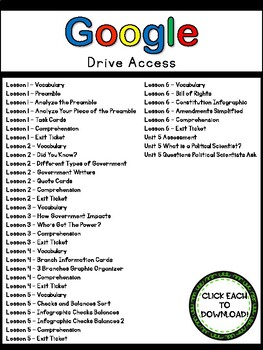4th Grade Social Studies Government Curriculum Google Slides
- PDF
What educators are saying
Also included in
- A full year of 4th grade social studies themed in the United States.DISTANCE & GOOGLE DRIVE LEARNING LINKS ARE AVAILABLE ON THE GOOGLE DRIVE ACCESS PAGE IN EACH UNITS PDF DOWNLOADAll Units Include:Lesson PlansComprehension PagesVocabulary CardsAssessmentsSuggested Read Alouds/VideosActivities &aPrice $50.00Original Price $66.00Save $16.00
Description
The fifth unit in my 4th grade Social Studies Curriculum series is themed in government and includes lesson plans, reading passages, assessments, activities, and more. Each activity is also linked and downloadable to Google Drive for use in Google Classroom or other platforms. Unit correlates to concepts in the MC3 curriculum and meets Michigan Social Studies standards.
UPDATE: All files have been edited and updated where necessary!
GOOGLE DRIVE ACCESS LINKS ARE AVAILABLE IN THE PDF DOWNLOAD ON THE GOOGLE DRIVE ACCESS PAGE
Want to see a lesson example? CLICK HERE TO DOWNLOAD A FREE LESSON!
Lesson Plan Titles:
Lesson 1 – Why Do We Need Government?
Lesson 2 – What Kind of Government Do We Have?
Lesson 3 – What Powers Does the Government Have?
Lesson 4 – Branches of the Federal Government
Lesson 5 – Checks and Balances
Lesson 6 – The Bill of Rights
This unit includes:
6 Lesson plans
6 Reading Comprehension Activities
6 Exit Tickets
36 Vocabulary Word Cards
36 Cut-Out Vocabulary Cards
36 Vocabulary Define & Draw Guide
Poster Printables
Anchor Charts
Activities for each lesson
End of Unit Assessment
Vocabulary Cards Include
Government
Federal Government
Constitution
Preamble
Founders
Popular Sovereignty
Core Democratic Values
Limited Government
Republic
Representative Government
The Common Good
Constitutional Government
Laws
Rule of Law
Levels of Government
Shared Powers
Reserved Powers
Delegated Powers
Separation of Powers
Legislative Branch
Executive Branch
Judicial Branch
Senator
Representative
President
Cabinet
Supreme Court
Checks and Balances
Veto
Override
Judicial Review
Unconstitutional
Bill of Rights
Amendment
Individual Rights
Branches of Government
4th Grade Social Studies
Unit One - Social Science Foundations
Unit Two - United States Geography
NEED MORE SOCIAL STUDIES? Check out my YEAR LONG bundles!
1st Grade Year Long Social Studies
2nd Grade Year Long Social Studies
3rd Grade Year Long Social Studies
Thank you for looking at my products! Feel free to contact me with any questions.
Don't forget to follow me for updates, sales, and flash freebies!




